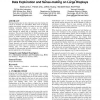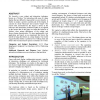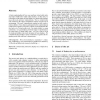VLUDS
2010
13 years 9 months ago
2010
Large high-resolution displays combine the images of multiple smaller display devices to form one large display area. A total resolution that can easily comprise several hundred m...
AVI
2006
14 years 4 months ago
2006
During grouping tasks for data exploration and sense-making, the criteria are normally not well-defined. When users are bringing together data objects thought to be similar in som...
EICS
2009
ACM
14 years 7 months ago
2009
ACM
dTouch is a novel 3D pointing system that allows interaction with large displays from the use of a single webcam. An initial evaluation demonstrating the feasibility of our pointi...
UIST
2004
ACM
14 years 8 months ago
2004
ACM
We describe a new widget and interaction technique, known as a “Frisbee,” for interacting with areas of a large display that are difficult or impossible to access directly. A ...
AFRIGRAPH
2004
ACM
14 years 8 months ago
2004
ACM
A better understanding of how users perform virtual reality tasks may help to build better virtual reality interfaces. In this study, we concentrate on the impact of large display...
MM
2005
ACM
14 years 8 months ago
2005
ACM
We present the uPen, a laser pointer combined with a contactpushed switch, three press buttons and a wireless communication module. This novel interaction device allows users to i...
OZCHI
2006
ACM
14 years 9 months ago
2006
ACM
Large displays are everywhere. However, the computer mouse remains the most common interaction tool for such displays. We propose a new approach for fingertip interaction with lar...
C5
2006
IEEE
14 years 9 months ago
2006
IEEE
We present a framework that we are developing to better solve several critical issues that arise when interactive systems are extended to large displays. These issues include slow...
CHI
2003
ACM
15 years 3 months ago
2003
ACM
A common observation when working on physically large displays, such as wall-sized projection, is that a certain amount of information privacy is lost. A common explanation for th...
CHI
2004
ACM
15 years 3 months ago
2004
ACM
Previous results have shown that users perform better on spatial orientation tasks involving static 2D scenes when working on physically large displays as compared to small ones. ...





